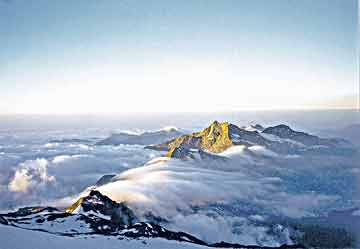
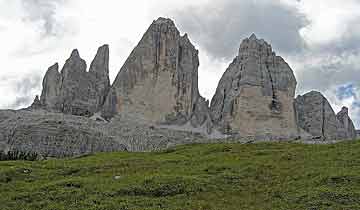
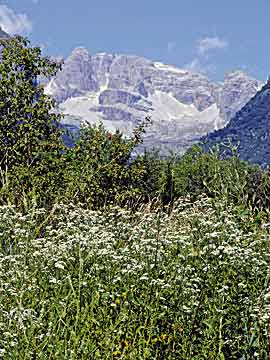
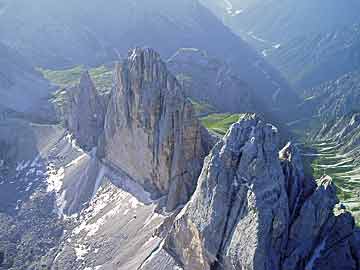
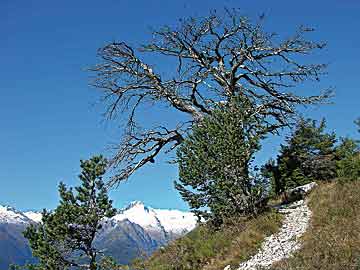
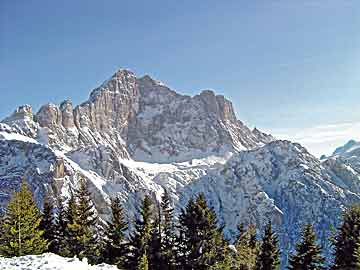
|
|
What is that inexpressible feeling? That feeling of awe, of being lost, which strikes us every time our gaze lingers on the shape, on the gorges, on the outline and colours of a mountain? That penetrating sensation which characterized – as Merleau Ponty put it “that mute contact with things, when they are still unspoken”, or in the words of Paul Guichonnet, “those ghosts with no natural connection to the surrounding environment”. Writers, philosophers, thinkers, have tried to describe it, to speak of it, thus giving rise to a true and proper Aesthetics of the Alps which, even today, represents a point of entry to speculation about the landscape. At the same time, it suggests a new but still ancient relationship of scale between Man and nature.
Until the Renaissance, if one excludes some passages by the divine Homer who defined the mountains as “the monstrous burdens of the earth”, and Petrarch, who speaks of them at length in his famous description of an excursion on Monte Ventoso, the topic of the mountain had been the impenetrable one of ‘the elevated places’. Places man had to stay away from. Perhaps it was the home of the gods, of the devil and witches, but in any case an environment which man had to stay well clear of, both physically and mentally.
Leonardo da Vinci, at the dawn of the Renaissance, showed a marked theoretical interest for mountains: he explored them in person, in a certain sense becoming a climber, drawing on their contemplative aspects in many of his works.
It was Josua Simler, though, in 1576, with his splendid Alpine descriptions who provided new light on the vision of these earthly colossi. Simler wrote that “the sublime nature of the mountains deserves our most devoted contemplation”, as there, if one observes them in detail, “as you look, you are filled with wonder and you will find a great number of excellent and singular things”. Konrad Gesner, a few decades earlier, in 1541, had stated, “I declare an enemy of nature anyone who does not judge the high mountains worthy of long contemplation. Certainly the highest altitudes seem to be beyond ordinary conditions and are beyond our reach, as if they were part of another world”.
The Enlightenment tried to deconstruct the mythical and spectral spell which enshrouded the mountains, revealing them for what they were and are: “superimposed rocky layers”, as Luis Trenken said, “of the most disparate origins, forced to grow upwards by the push of powerful forces inside the earth. In these revealed mountains one could observe, study and climb, to remove every mystery, with the help of the exact sciences”.
Even during and after the century of Enlightenment, there were those who resisted with a contemplative-aesthetic attitude, like George Simmel, and others who, like Georg F.W. Hegel, previously, in 1817, could not help but examine the relationship between the mountain and the men who live on it: “I doubt that even the most credulous theologian would dare, here, on these mountains in general, to attribute to Nature itself the purpose of usefulness for man, the latter being forced to steal from her, to steal the miserly portion he can use; never sure he will not be crushed by rocks or landslides during his miserable thefts, whilst taking a handful of grass. Nor can he be sure his toil will not be destroyed overnight, whether his hut or the cowshed”.
“The impression the high mountain makes on us is that it is a symbol and a presentiment of the fact that life redeems itself, making the most of its powers, in that the mountain doesn't fit our mould, but towers over us and has to be faced” wrote Georg Simmel in an essay dedicated to the ‘Alps’. In 1892, he was one of the first to give mountains a lyrical voice, giving depth and global significance to those emotions which for millennia had remained closed in the hard hearts of the inhabitants of the valleys below: “When, as in the Alps, shapes are brought together completely by chance, without an all-encompassing line which joins them together, even a single line would not find its place in the overall picture and would remain isolated, were it not for the perceptible mass of matter that extends uniformly beneath the peaks and transforms their meaningless isolation into a coherent body”.
Today, there is a ‘terrible modernity’ binding the Alps to the world of tourism and finance, making them prisoners of a relationship that exploits them rather than exalting them in man's need for contemplation. They are relegated to no more than the stage for man’s sporting vanity. If the Alps wish to survive all this, they will have to retrieve their abstract and physical relationships with the emotions. The emotion of contemplation. The mountain as the place where one’s own identity is revealed. The mountainous horizon, not as the scene of offensive exploits, but as a mirror of the soul. |
